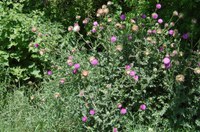Fall Good Time to Manage Some Pasture Weeds
(Click the image below to view a high-resolution image that can be downloaded)
Fall is the best time to control some of North Dakota’s most notorious weeds in pastures and other grasslands, according to North Dakota State University Extension specialists.
“Leafy spurge and invasive thistles can be challenging to control in pasture and grasslands due to their extensive root systems,” says Miranda Meehan, Extension livestock environmental stewardship specialist. “In the fall, plants begin to allocate energy to their root systems. As a result, fall herbicide treatment maximizes injury to the root system.”
Here is advice on dealing with some of the worst weeds.
Leafy Spurge
“Proper timing of herbicide applications is essential for good leafy spurge control,” says Extension rangeland management specialist Kevin Sedivec.
In the fall, leafy spurge is most susceptible to Tordon (picloram), dicamba (Banvel and other trade names), Facet L (quinclorac), Facet L + Overdrive and Method (aminocyclopyrachlor). Fall-applied Plateau (imazapic) provides better long-term control and causes less grass injury than spring or summer treatments.
The combination of Tordon plus Overdrive also will improve leafy spurge control compared with Tordon used alone. Overdrive contains dicamba plus difluenzopyr, which is an anti-auxin compound that often improves broadleaf weed control when applied with auxinlike herbicides such as Tordon, dicamba and 2,4-D.
To achieve the greatest control, the treatment must be applied at the appropriate stage of development. Tordon, dicamba and Facet L should be applied when the plant has 4 to 12 inches of regrowth. However, Method is most effective when applied at the rosette stage. Overdrive should be applied prior to a killing frost.
Leafy spurge control must be considered a long-term management program, the specialists say. Research at NDSU has shown that more of the root system is killed when a combination of control methods is used, compared with any method used alone.
Thistles
Thistles tend to invade overgrazed or otherwise disturbed pastures, rangeland, roadsides and waste areas. Fall is the ideal time to treat many on the noxious thistle list, including Canada thistle, musk thistle and bull thistle. If you are unsure of what thistle you have, refer to the NDSU Extension publication “The Thistles of North Dakota” (https://www.ag.ndsu.edu/publications/crops/the-thistles-of-north-dakota).
Control of Canada thistle is usually greater when treatment is applied in the fall to plants in the rosette form. Herbicides that control Canada thistle in noncropland include products that contain clopyralid (various), Tordon (picloram), dicamba (various), dicamba plus diflufenzopyr (Overdrive), Method (aminocyclopyrachlor) and Milestone (aminopyralid).
Fall is the preferred time for applying herbicides to biennial thistles, such as musk thistle and bull thistle. This allows for application at the rosette stage, when the plants are most susceptible to herbicides.
Herbicides should be applied as late as possible in the fall, but prior to a killing frost, to allow for maximum seedling emergence and rosette size. Seedlings that emerge after spraying will remain vegetative until the following spring and can be treated then.
Biennial thistles can be controlled effectively with Milestone (aminopyralid), Stinger, Transline or Curtail (clopyralid), Tordon (picloram), Method (aminocyclopyrachlor), or dicamba (various) or dicamba plus diflufenzopyr (Overdrive).
Consult NDSU Extension Service publication W253, “North Dakota Weed Control Guide” (https://www.ag.ndsu.edu/publications/crops/north-dakota-weed-control-guide) for the latest recommendations for noxious weed control with herbicides. Grazing restrictions vary with herbicide and application rate, so read the label carefully before using any product.
NDSU Agriculture Communication - Sept. 9, 2020
Source: Miranda Meehan, 701-231-7683, miranda.meehan@ndsu.edu
Source: Kevin Sedivec, 701-424-3606, kevin.sedivec@ndsu.edu
Editor: Ellen Crawford, 701-231-5391, ellen.crawford@ndsu.edu


